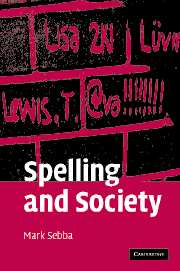Book contents
- Frontmatter
- Contents
- Illustrations
- Maps
- Diagrams
- Tables
- Acknowledgements
- Note on transcription
- 1 Map showing location of languages in Europe mentioned in this book
- 2 Map showing location of languages outside Europe mentioned in this book
- Introduction: society and orthography
- 1 Approaching orthography
- 2 Orthography as social practice
- 3 Language contact, linguists and the emergence of orthographies
- 4 ‘Postcolonial’ Orthographies
- 5 Between language and dialect: orthography in unstandardised and standardising vernaculars
- 6 Reform or revolution: where angels fear to tread
- 7 Why do we spell?
- Glossary
- References
- General index
- Index of language names
- Index of surnames
4 - ‘Postcolonial’ Orthographies
Published online by Cambridge University Press: 22 September 2009
- Frontmatter
- Contents
- Illustrations
- Maps
- Diagrams
- Tables
- Acknowledgements
- Note on transcription
- 1 Map showing location of languages in Europe mentioned in this book
- 2 Map showing location of languages outside Europe mentioned in this book
- Introduction: society and orthography
- 1 Approaching orthography
- 2 Orthography as social practice
- 3 Language contact, linguists and the emergence of orthographies
- 4 ‘Postcolonial’ Orthographies
- 5 Between language and dialect: orthography in unstandardised and standardising vernaculars
- 6 Reform or revolution: where angels fear to tread
- 7 Why do we spell?
- Glossary
- References
- General index
- Index of language names
- Index of surnames
Summary
Nationalism ‘aided by a pyre’
Amongst the Albanians there was an extraordinary struggle of alphabets. Albanian used to be written in three different scripts: the Greek, by members of the Orthodox Church and by many Mohammedans influenced by Greek culture; the Arabic, by particularly loyal subjects of the Porte; finally the Latin was adopted by the modern nationalist movement. The Latin carried all before it, aided in 1913, by a pyre which disposed of Albanian books in the Arabic script.
(Kolarz 1946: 21–22)In August 1990, a two-day festival was held in Chişinău, capital of what is now the independent republic of Moldova, but was then still (barely) the Soviet Socialist Republic of Moldavia. The festival, called Limba Noastra, ‘Our Language’, celebrated the first anniversary of the reintroduction of the Roman alphabet to the Moldovan language, which until that time had been written using the Cyrillic alphabet. In changing scripts, written Moldovan simultaneously became ‘reunited’ with the Romanian language, with which it is mutually intelligible. In Romania, the Cyrillic script was used until the beginning of the nineteenth century, when ‘the ideology of their Latin origin led to adoption of the Latin alphabet, though it was incapable of conveying all the sounds in the Rumanian language’ (Kolarz 1946: 22); the use of Cyrillic was actually forbidden in Romania after 1863.
- Type
- Chapter
- Information
- Spelling and SocietyThe Culture and Politics of Orthography around the World, pp. 81 - 101Publisher: Cambridge University PressPrint publication year: 2007



